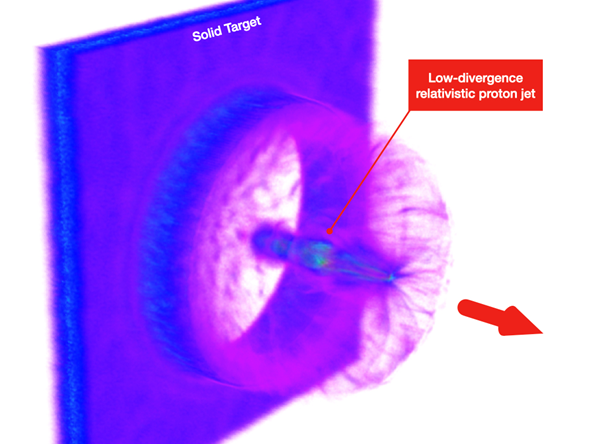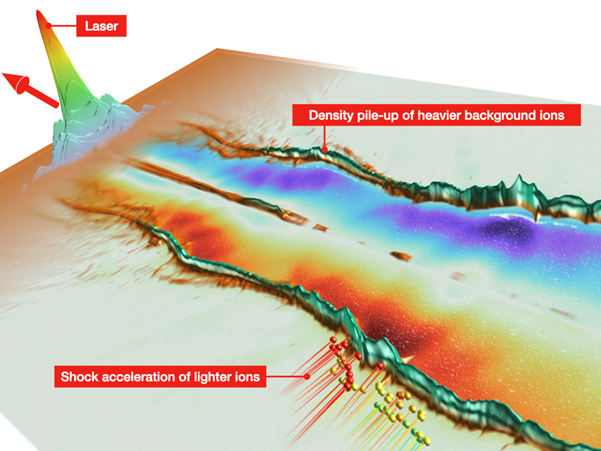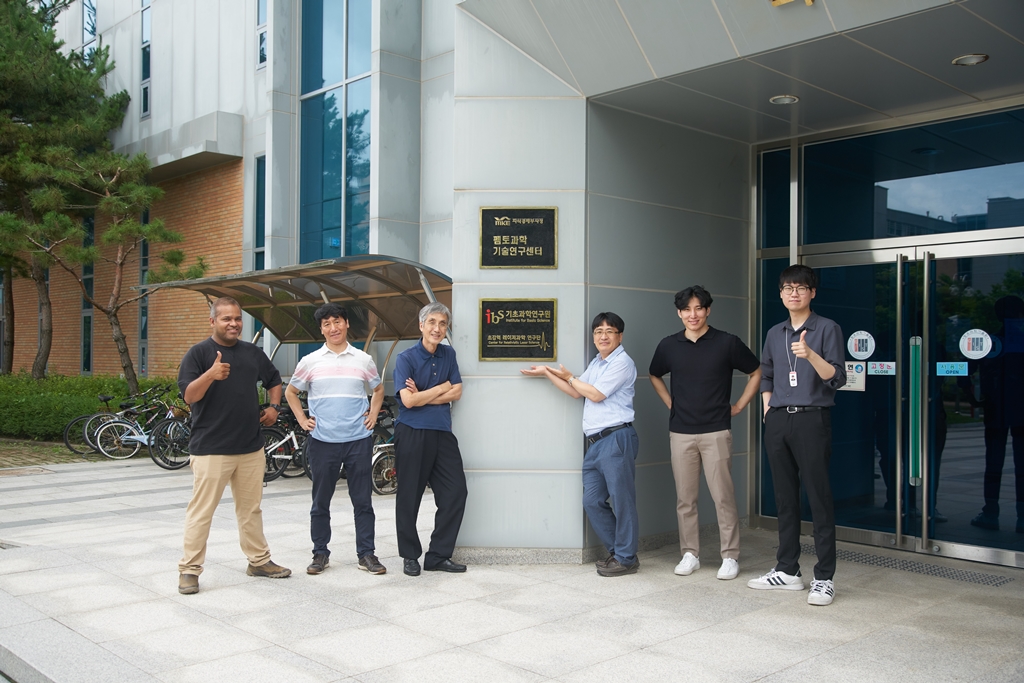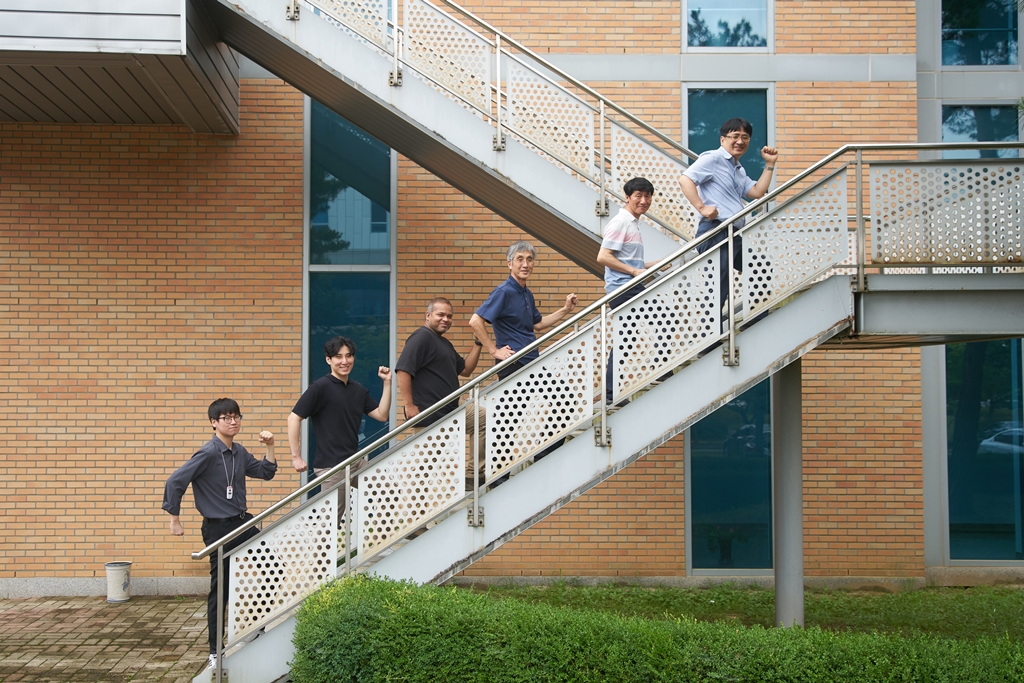Center for Relativistic Laser ScienceExplore the interaction between ultra-intense light and matter
mainmenu
▪ Research overview
Ultrahigh intensity lasers lead us to an unexplored territory of physics, to which other terrestrial means cannot. Upon impinging on a material, an ultra-intense laser immediately turns the material into a plasma exhibiting novel phenomena, such as collective relativistic plasma motions, strong radiation reaction effects, and nonlinear quantum electrodynamic processes. The dynamics in such a physical system is highly nonlinear, couples multiple frameworks of physics (classical electrodynamics and quantum electrodynamics), and is embodied through the processes at multiple spacetime scales. Understanding the new physics of such extreme conditions and utilizing it for other scientific or technological purposes has been highly fascinating research opportunities for the last few decades. The laser-plasma theory group investigates the physics problems in ultra-intense laser-plasma interactions, utilizing analytical and numerical studies, as well as by performing particle-in-cell and hydrodynamic simulations. The group also closely collaborates with the experimental groups by proposing new schemes, numerically testing experimental setups, and interpreting experimental results.
▪ Research areas
· Relativistic laser-plasma interaction
· Strong-field quantum electrodynamics
· Laboratory astrophysics
▪ Relativistic laser-plasma interaction
Through the last decades, the theoretical frameworks for relativistic laser-plasma interactions have been established, and various schemes have been proposed and investigated to produce high-energy particles: laser wakefield acceleration for electrons, target normal sheath acceleration and radiation pressure acceleration for ions, and relativistic mirrors for photons. Despite remarkable progress, the schemes per se are not sufficient for practical particle sources. Therefore, much effort is being put to improve these basic schemes by engineering laser pulses, targets, and interaction configurations. Such improvement, not a simple optimization, requires a thorough understanding of the relevant processes and the ability to control the processes.

Generation of a collimated high-energy proton beam: When a Laguerre-Gaussian impinges on an ultrathin solid foil, the radiation pressure of the hollow-profile pulse accelerates and focuses protons in the foil, yielding a highly collimated high-energy proton beam. [K. H. Pae et al., Plasma Phys. Control. Fusion 62, 055009 (2020)]
▪ Strong-field quantum electrodynamics
Quantum electrodynamics (QED) in the nonlinear regime has been studied theoretically almost for a century, but its experimental investigation has become possible only recently. In the collision of GeV electrons with an ultra-intense laser pulse with an intensity over 1021 W/cm2 , the electric field felt by the electrons reaches the intrinsic scale of QED, 1.3x1018 V/m, and nonlinear QED phenomena such as nonlinear Compton scattering and nonlinear Breit-Wheeler pair production can occur. At higher laser intensities, these processes can proceed in cascade, resulting in QED plasmas, where plasmas, electrons, positrons, and gamma-ray photons are strongly coupled. Furthermore, such QED plasmas are crucial in the high-energy processes near compact astrophysical objects like black holes, pulsars, and magnetars.
Generation of electron-positron pair and gamma photons: 3D PIC simulation-animation of collision between an ultra-intense laser pulse(orange) and a high-energy electron beam. Grey spheres represent electrons, green spheres represent gamma photons, and blue spheres represent positrons.
▪ Laboratory astrophysics
As 99% of the visible Universe is in the plasma state, plasma dynamics is an essential aspect of astrophysical processes that typically involve high-speed flows or high-energy particles. Because ultra-intense laser-plasma interactions can offer such high-energy elements, we may realize scaled-down astrophysical plasma processes by using laser-plasma experiments. The important astrophysical processes that are considered for laboratory emulations are as follows: Biermann battery mechanism, hydrodynamic and kinetic instabilities, turbulence, turbulent dynamo, collisionless-shocks, cosmic ray acceleration, gamma-ray bursts, and pulsar magnetosphere. Such laboratory emulations would provide the method of controlled experiments to astrophysics research that has depended only on observation, analytical models, and simulations. Through laboratory emulations, we may confirm theoretical predictions and discover new physical processes.

Development of fluid instabilities in the collision of two corrugated plasma flows (left), and the accompanying magnetic field amplification (right). [C.-M. Ryu et al., High Energy Density Phys. 31, 74 (2019)]
▪ Recent Research Topics
· All optical two-color dual-staged laser wakefield acceleration
· Nano-particle-induced external injection in laser wakefield acceleration
· Relativistic proton jet by an ultra-intense circularly-polarized LG laser pulse
· Nonlinear Compton scattering and nonlinear Breit-Wheeler pair production
· Inertia dependent shock-acceleration in near-critical density plasma
· Effect of Biermann battery in turbulent dynamo
· Electron-positron pair generation by high-energy electrons
· Spatial-temporal dynamics of beam-plasma instabilities

Inertia dependent shock acceleration of protons from shock created in helium-plasma by a high-intensity short-pulse laser (Simulation done with OSIRIS PIC code).[P.K Singh, V. B. Pathak et al. , Scientific Reports, 10, 18452 (2020)]
▪ Publications
· P. K. Singh, V. B. Pathak et al. , “Electrostatic shock acceleration of ions in near-critical-density plasma driven by a femtosecond petawatt laser,” Scientific Reports, 10, 18452 (2020).
· K. H. Pae et al., “Low-divergence relativistic proton jet from a thin solid target driven by an ultra-intense circularly polarized Laguerre–Gaussian laser pulse,” Plasma Physics and Controlled Fusion, 62, 055009 (2020).
· C.-M. Ryu et al., “Biermann battery effects on the turbulent dynamo in a colliding plasma jets produced by high-power lasers,” High Energy Density Physics, 31, 74 (2019).
· T. W. Huang et al., “Highly efficient laser-driven Compton gamma-ray source,” New Journal of Physics, 21, 013008 (2019).T. W. Huang et al., “Tabletop laser-driven gamma-ray source with nanostructured double-layer target,” Plasma Physics and Controlled Fusion, 60, 115006 (2018).
· M. H. Cho, et al., “Controlled electron injection facilitated by nanoparticles for laser wakefield acceleration,” Scientific Reports, 8, 16924 (2018).
· V. B. Pathak et al., “All optical dual stage laser wakefield acceleration driven by two color laser pulse,” Scientific Reports, 8, 11772 (2018).
▪ Members (as of Dec. 2021)
· Research fellows (4)
Vishwa Bandhu Pathak, Ki Hong Pae, Duck Jae Jang, and Chul Min Kim (group leader)
· Consulting scientist (1)
Chang-Mo Ryu
· Graduate students (1)
Hoon Song (Ph.D. candidate)




